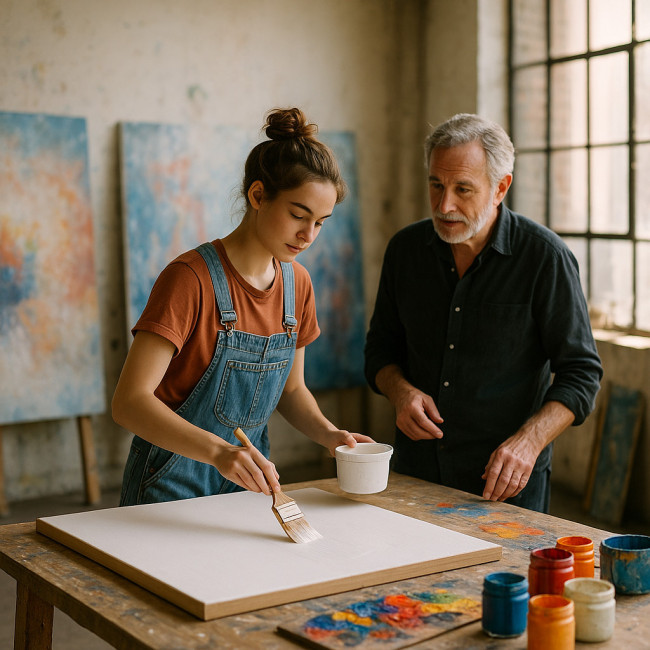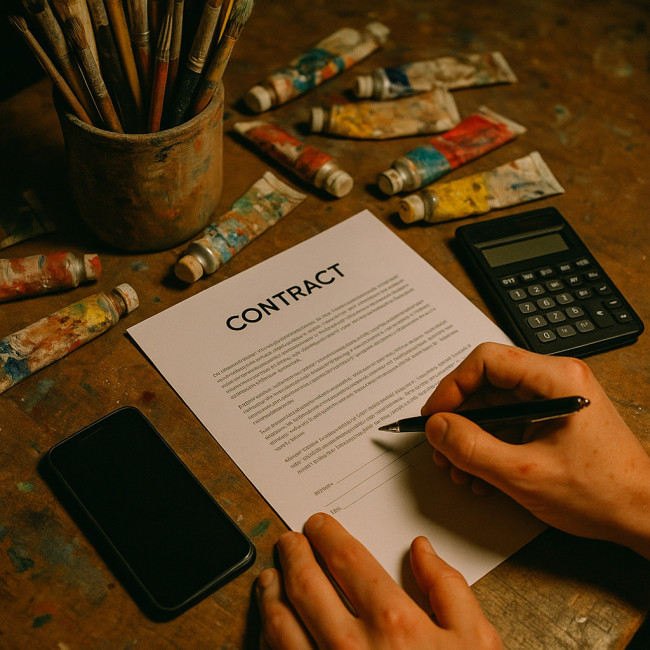Painter assistant roles: stepping-stones toward gallery representation
Starting as a painter assistant remains one of the fastest, most affordable ways to refine technique, build industry contacts and ultimately secure gallery representation. This guide explains how the role works, what skills you gain, and the exact actions that turn backstage experience into solo shows.
Why begin your journey as a painter assistant?

Painter assistant roles give you daily studio access, mentorship and a paycheck—three essentials that young artists often chase separately. While helping an established painter prep canvases or pack work for shipping, you absorb workflows that schools rarely cover. You also watch client negotiations, collector visits and curator feedback unfold in real time. All those moments shorten your learning curve and grow your confidence.
- Immediate immersion in professional studio habits.
- Chance to test materials without funding every experiment yourself.
- Access to a network of galleries, framers and art handlers.
- Regular income that keeps you painting instead of taking unrelated gigs.
Core responsibilities you will master
Each studio runs differently, yet most painter assistant roles include these recurring tasks. Treat them as micro-classes in production, logistics and client relations.
| Assistant role | Typical tasks | Skills gained | Average day rate (USD) |
|---|---|---|---|
| Studio Preparation | Gesso canvases, mix pigments, organise tools | Surface chemistry, colour consistency, speed | 150 |
| Artwork Finishing | Varnish, frame, stretch and label pieces | Archival standards, framing math | 180 |
| Cataloguing & Shipping | Photograph, document, crate, liaise with shippers | Inventory software, packing specs | 200 |
| Client-Facing Support | Install shows, manage studio visits, sell prints | Sales language, presentation flow | 220 |
Career roadmap: from assistant to represented artist
1. First 6 months – technical foundation
Focus on perfect priming, clean edges and colour matching. Document every formula in a personal log. Use breaks to sketch small studies—never compete with the lead painter's active series.
2. Months 6-18 – portfolio building
Ask permission to use off-cuts and expired pigments for your own pieces after hours. Photograph progress. Post weekly snippets on social channels, tagging the studio only with consent. Our article on refreshing painter websites with high-resolution images shows how to keep files sharp yet fast.
3. Year 2 – micro showings
Leverage the collector foot traffic entering the studio. When they wait for the lead artist, politely mention your latest study stacked in the corner. Many assistants land first sales that way. For bigger visibility, volunteer small pieces to painter pop-up events that attract gallery scouts.
4. Year 3 – pitch to galleries
Compile your strongest 12 works. Highlight assistant experience as proof you understand deadlines and presentation. Include quick metrics—on-time delivery, no damages, mounting speed—to reassure gallery managers.
How to choose the right painter to assist
Not every prolific artist is a constructive mentor. Evaluate these factors before you sign any contract.
- Overlap in medium and concept: If you love abstraction, assisting a hyper-realist may drain your creative drive.
- Studio scale: A small loft offers hands-on instruction; a warehouse with 12 assistants teaches efficiency.
- Exhibition cadence: Frequent shows mean you learn installation and shipping quickly.
- Mentorship style: Some painters explain decisions; others expect silent execution. Ask past assistants for truth.
Legal and pay considerations

Always sign a written agreement that outlines rate, overtime rules, nondisclosure and credit. In markets like New York or Berlin, $18–25 per hour is common for junior tasks, rising as you handle sales or curatorial duties. Compare terms with other creative disciplines by skimming our fair-pay checklist for photography assistants; many clauses translate perfectly.
Portfolio building while assisting
Document your personal work separately from studio pieces. Use different storage drives and watermarks. When sharing progress online, respect embargo dates for the lead artist's upcoming exhibitions. Embed alt-text such as “oil study made during painter assistant role” to reinforce your keyword relevance.
Need keyword inspiration? The 2025 Painter SEO playbook explains how to integrate assistant credits into meta descriptions and captions.
Digital visibility: leverage assistant credits online
Your résumé should list measurable outputs: “Prepared 60 exhibition-ready canvases in four weeks,” “Managed a 300-piece digital inventory with 0% data loss.” Recruiters browsing artist collaboration directories filter by these metrics. Add them as bullet points under each role.
Real-world examples of assistants who made the leap
- Ava Delgado – Assisted a colour-field veteran in Madrid; solo show within 28 months using leftover pigment batches.
- Leon Wu – Documented large mural installs; galleries praised his logistical notes and offered representation.
- Mira Patel – Ran CRM emails for her mentor; later pitched the same contacts her intimate gouache series.
Check your knowledge
FAQ
- Do painter assistants receive public credit?
- Credits vary by studio. Negotiate listing on wall labels or catalogs before starting.
- Can I sell my own art while assisting?
- Yes, but keep production and storage separate to avoid IP disputes.
- How long should I stay in an assistant role?
- Remain until you master skills you lack—usually 18-36 months.
- What if a studio asks me to sign an NDA?
- Nondisclosure is normal. Review scope to ensure you can still discuss your personal work.
- Is formal education required to assist?
- No. Portfolio and punctuality matter more than degrees.
Next step: turn knowledge into action
Ready to find your first role? Draft a concise email, attach a five-piece PDF and highlight one efficiency you can bring on day one. Then schedule informational visits at three studios this month. Small, steady moves now build the track record galleries love.
Turn studio time into showtime—start assisting and paint your path to representation today.











